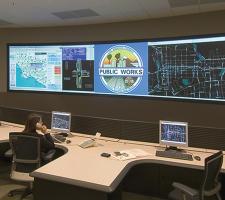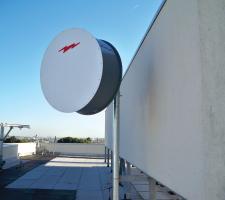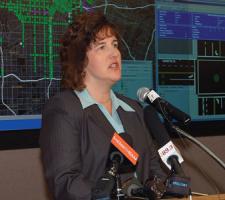
Jane White, LA County Public Works ITS programme manager
An extensive hybrid communications network in the County of Los Angeles is proving the capability and benefits of modern wireless technology for traffic management across wide areas.
Wireless communications technology has found a welcoming test bed for use in traffic management systems, in the County of Los Angeles. The county has long running programmes synchronizing and monitoring traffic signals over large areas. In the process, combined with installation of advanced traffic management systems (ATMS), the county’s Department of Public Works has found good reason to explore greater use of wireless in combination with fibre optic and twisted pair cables. The results are an expansive hybrid communications system, with a good deal of knowledge gathered and lessons learned along the way.According to LA County Public Works’ ITS programme manager Jane White, the county’s new communications network will be further expanded and improved upon to give greater redundancy and reliability. A connection failure at one intersection can cause up to 20 sites to be taken out of the system. “The key to it is finding the optimum density of equipment,” she says.
Public Works is yet to hit its sweet spot of connectivity in parts of the county, but it has found a cost effective way of
linking up the traffic signals of a large area. The hybrid network does not include the City of Los Angeles, but extends out
from Public Works’ traffic management centre in Alhambra City to Santa Clarita 50 miles to the north, to Long Beach 40 miles
south and to the San Bernardino County line 25 miles east.
“We looked at creating the network with fibre optic cables at first, through use of leased telephone lines, but the costs of this option were too high. Wireless communications were considered not effective enough at the time, but the technology has developed as we have gone through the process. It’s got a lot better,” White says.
Jurisdictional cooperation
Since 1995, Public Works has led the LA County Forum Programme, which is focused partly on upgrading and synchronising traffic signals across agency jurisdictions.The Forum is also intended to provide the means for agencies of the county’s 88 cities to work together on traffic management improvements. Around 20 cities are participating in each of the three current forums of the San Gabriel Valley, South Bay and Gateway Cities regions.
Following each city’s upgrade of signals to full traffic actuation and time based synchronization, ITS systems have been installed for monitoring and managing traffic. This is being done either from cities’ own traffic management centres or from Public Works’ Alhambra TMC.
The size of cities’ engineering departments and available resources varies a great deal. Those wanting to operate their own ATMS have done so with technical support from Public Works and funding through a grant from Metro, the LA County
An alternative approach
Installation of the critical communications network for these systems has accelerated over the past five years, following a pilot wireless installation project in the South Bay area of the county. Public Works had already realised a hybrid form of network was needed, partly due to a lack of good fibre cable in the ground in some localities, as well as the prohibitive costs of leased telephone lines. A specification had also been developed for the pilot project connecting 51 intersections in South Bay – based on providing two separate wireless systems for traffic signal and CCTV data – before Public Works’ selected vendor proposed an alternative approach.This would transmit both traffic signal and video data on a single system using ethernet broadband radios. Public Works’ initial double-system design would have communicated traffic signal and CCTV via wireless radio to a nearby central facility from where it would have been combined and transported back to the Alhambra TMC using a leased T-1 telephone line. One T-1 line would be needed for every eight intersections to support the ‘once-per-second’ communication needs of an arterial ATMS. Additional T-1s would be needed for video data; and the design was limited by providing all traffic signal data to Public Works’ ATMS servers via RS232 standard serial communications interfaces.
The alternative approach would support this requirement by taking the RS232 traffic signal controller data, encapsulating it within an IP packet and communicating it back to the Alhambra TMC via ethernet broadband radio. As Public Works’ ATMS was not set up for IP-based communications, once the data reached Alhambra, it would be converted back to RS232 using an ethernet to serial converter.
Installation spread wide
It was this approach that was taken forward for the six month pilot project initiated in 2006. This is also effectively the start date for widespread installation of LA County’s wireless and fixed hybrid communications, because the ongoing long term roll out has continued in a similar vein, albeit to include 1000 intersections, 59 CCTV sites and eight other city TMCs.The full blown installation has benefitted from a number of important lessons learned during the pilot project: Correct location of radios at height, avoiding interference from trees and buildings was significant; spare cables were added where any were pulled, to allow later addition of further radios or switching of cables if one was damaged; and a need was discovered to link each base radio to specific subscriber radios, to prevent – in the event of a base radio failure – subscribers trying to connect to another base radio, creating a loop and causing the communications to crash.
These difficulties overcome, controller data from all 51 intersections and CCTV data from four cameras was communicated on one T-1 line, at the desired ‘once per second’ rate, giving Public Works the confidence necessary to order the wider roll out. In similar fashion to the pilot project, the larger contract was set up as a performance-based IT services arrangement.
The vendor, selected on the basis of a qualification procedure, was required to determine the feasibility of connecting wirelessly to each site and then paid a fixed cost for every intersection that can be accessed remotely by Public Works’ TMC.
Significant savings
Some elements of the project were changed as the wider roll out commenced: Limitations of serial-based ATMS had to be overcome, by converting it to a full IP solution; and Public Works opted to have its own personnel install the radios, with technical and training support from the contractor, cutting costs per intersection by 30%. Last, but by no means least, wireless radio backhaul links were introduced. With growing confidence in wireless, these broadband connections up to 200Mbps in speed have been tested and proven for transporting traffic signal and CCTV data from LA County’s regional fibre optic networks to Public Works’ Alhambra TMC, with further reduction in use of leased T-1 telephone lines.According to Jane White, recurring cost savings have been significant – at least $500,000 in yearly T-1 line rental costs alone.
Public Works has also started to realise the benefits of such a large communications network, having the ability to rapidly diagnose and deal with traffic problems. “And we’ve found a way of installing such a network cost effectively,” she says.
“We are now about two-thirds through deployment of wireless connectivity to 1000 intersections. We will look to deploy and
expand further but the biggest constraint now is funding. It is likely that we will extend in increments of a hundred sites in future, but we have most of the county’s major arterial roadways now covered and we have built a lot of wireless network expertise in our in-house teams















